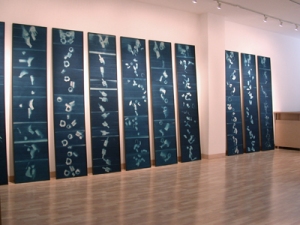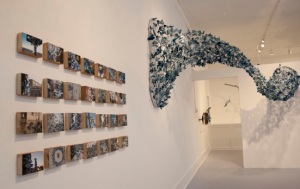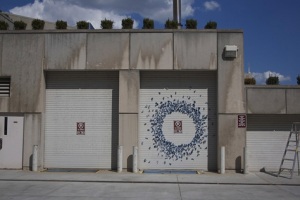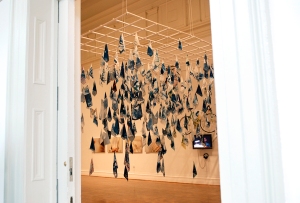Considering I am working with cyanotypes at the moment I felt it was important that I researched some other artist who work with this process. Cyanotype is an old photographic process (that now sits under the alternative processes), that was first published by Sir John F.W Herschel in 1842. This process was not initially developed by Herschel for making photographic prints, but as a means for duplicating mathematical tables. The earliest known photographic illustrated book, using this cyanotype method, was made by Anna Atkins in 1843. The process is very simple as it uses a mixture of 2 chemicals, Potassium ferricyanide & Ferric ammonium citrate which are painted on paper or cloth, dried in a dark space and the using a negative or any material, laid in the sun to expose. The chemical mixture reacts to the UV rays of the sun, turning the dried yellow stain into a browny colour, which upon washing in water becomes blue. My reasons for using this process are:
- Its historic significance in relation to the plant material I am using, as these are plants that we can eat, but this knowledge is either forgotten or simply not passed on. We now consider these plants as weeds and a nuisance
- True blue is not often seen in plants (in flowers more specifically) - I felt that by using this process I could ‘create edible blue plants’.
- Plants grow utilizing the sun and these images have grown through exposure to the sun
- The cyanotype is a blueprint, it is the negative image of the original (allowing reproduction to occur of the positive if you so desire).
 The process also fascinates me, as dependent on the strength of the sun, the material you paint the solution on and the length of time you leave it to expose will give you varying shades of blue. This adds a bit of the unknown to the work, which I like and need (I like to control things too much, so this creates a level of unknown to me that is good for my practice). I do wonder whether you have to like blue to like any work made with this process? Or if the blue colour will create negative associations of any work made with this process? Only time and an up in coming peer & faculty critique will tell. Blue imagery does make you think of a blueprint or genetic code for something. These images are just that, they show an outline of the image used and as such ‘hold the genetic’ truth of that image. What is also fascinating is that they are a negative of the original. A negative is where lights and shade or colours are shown in the reverse of the original. So is this still a reproduction of the original gene or has it mutated into something new? It is interesting to discover how this process is used by artist, for both abstract and realistic imagery. Having found some great examples of both: Robin Hill’s work, Beach Debris 2003, is a series of 10 panels, where the images have been created on paper using the cyanotype
The process also fascinates me, as dependent on the strength of the sun, the material you paint the solution on and the length of time you leave it to expose will give you varying shades of blue. This adds a bit of the unknown to the work, which I like and need (I like to control things too much, so this creates a level of unknown to me that is good for my practice). I do wonder whether you have to like blue to like any work made with this process? Or if the blue colour will create negative associations of any work made with this process? Only time and an up in coming peer & faculty critique will tell. Blue imagery does make you think of a blueprint or genetic code for something. These images are just that, they show an outline of the image used and as such ‘hold the genetic’ truth of that image. What is also fascinating is that they are a negative of the original. A negative is where lights and shade or colours are shown in the reverse of the original. So is this still a reproduction of the original gene or has it mutated into something new? It is interesting to discover how this process is used by artist, for both abstract and realistic imagery. Having found some great examples of both: Robin Hill’s work, Beach Debris 2003, is a series of 10 panels, where the images have been created on paper using the cyanotype  process and these were mounted on the wood panels. These images she created using found debris, at the top image are a pair of hands, appearing to ‘hold onto and having lost control’ of the concertina of images that are ‘falling’ down. This gives the work a sense of movement and allows it to cascade down the wall. The display theme Hill has used reflects a model or a template, a gene, with the images mounted to vertical boards of identical sizes strengthens this. In her practice, “Hill collects random materials, situations, phenomena, and then makes decisions to wrestle the collections into her artwork. Often the constituent objects are tiny and insignificant on their own, but through that act of claiming them and acknowledging them, and through their contribution to the whole, they become monumental.” The question can be asked is; Do random items found on a beach belong together, because they have the location in common or have been documented through the same process? It does provided the items with a common link, a bit like a whakapapa or a ’location gene’. The cyanotype process allows for simple multiple reproductions of same or similar, making it a reproductive system in its own right. A completely different artist, Tasha Lewis, has used the cyanotype process in a reproductive yet, sculptural way, with an innovative
process and these were mounted on the wood panels. These images she created using found debris, at the top image are a pair of hands, appearing to ‘hold onto and having lost control’ of the concertina of images that are ‘falling’ down. This gives the work a sense of movement and allows it to cascade down the wall. The display theme Hill has used reflects a model or a template, a gene, with the images mounted to vertical boards of identical sizes strengthens this. In her practice, “Hill collects random materials, situations, phenomena, and then makes decisions to wrestle the collections into her artwork. Often the constituent objects are tiny and insignificant on their own, but through that act of claiming them and acknowledging them, and through their contribution to the whole, they become monumental.” The question can be asked is; Do random items found on a beach belong together, because they have the location in common or have been documented through the same process? It does provided the items with a common link, a bit like a whakapapa or a ’location gene’. The cyanotype process allows for simple multiple reproductions of same or similar, making it a reproductive system in its own right. A completely different artist, Tasha Lewis, has used the cyanotype process in a reproductive yet, sculptural way, with an innovative  final execution of the work. The sculptural pieces are created through the cyanotype process on material, which are sewn together to create the skin of the animal. The ‘broken’ body parts are held together by strong magnets through the various found & recycled materials. She describes the work as “The result is that the natural form — my main muse — appears to be both actively breaking through the enclosure while simultaneously remaining dependent on the solid form to give its body shape. Thus, these animals and plants are arrested during a surge of forward momentum. The ‘thaw’ of the show’s title is the apparent momentary loss of solidity that the glass container, wooden box or plaster wall has experienced which allowed nature to break through." You could ask why did she use the cyanotype process? For me it is simple: she has ‘created’ her own blueprint animals, cloned them from the real. The creatures are all placed in unnatural settings or spaces, on display in a museological format. Using the cyanotype method allowed her to create her own genetic forms and shapes, manipulating them to suit her ‘museum’. Lewis has also taken her butterflies into the real world and has used them in a form of Gorilla art, she calls Guerilla Sculpture.
final execution of the work. The sculptural pieces are created through the cyanotype process on material, which are sewn together to create the skin of the animal. The ‘broken’ body parts are held together by strong magnets through the various found & recycled materials. She describes the work as “The result is that the natural form — my main muse — appears to be both actively breaking through the enclosure while simultaneously remaining dependent on the solid form to give its body shape. Thus, these animals and plants are arrested during a surge of forward momentum. The ‘thaw’ of the show’s title is the apparent momentary loss of solidity that the glass container, wooden box or plaster wall has experienced which allowed nature to break through." You could ask why did she use the cyanotype process? For me it is simple: she has ‘created’ her own blueprint animals, cloned them from the real. The creatures are all placed in unnatural settings or spaces, on display in a museological format. Using the cyanotype method allowed her to create her own genetic forms and shapes, manipulating them to suit her ‘museum’. Lewis has also taken her butterflies into the real world and has used them in a form of Gorilla art, she calls Guerilla Sculpture.  With the 400 butterflies she covers walls, metal boxes etc to create a swarm of blue. This form of gorilla art is non-invasive or destructive, as the butterflies are moved on to various new locations. Only evidence left of the work is the documentation. An ephemeral approach that has been used by many other artist, one such artist is Andy Goldsworthy. Who uses natural materials found on site, manipulates these to create a work, photographs this work and then allows it to rot back and become part of nature again. The last artist who’s work inspired my current work with the napkins is Traci Marie Lee, with her work titled “I really was there; I was never really there”. It is an installation of 300 vintage handkerchiefs that have images of people and vintage fabric patterns on them through the process of cyanotype.
With the 400 butterflies she covers walls, metal boxes etc to create a swarm of blue. This form of gorilla art is non-invasive or destructive, as the butterflies are moved on to various new locations. Only evidence left of the work is the documentation. An ephemeral approach that has been used by many other artist, one such artist is Andy Goldsworthy. Who uses natural materials found on site, manipulates these to create a work, photographs this work and then allows it to rot back and become part of nature again. The last artist who’s work inspired my current work with the napkins is Traci Marie Lee, with her work titled “I really was there; I was never really there”. It is an installation of 300 vintage handkerchiefs that have images of people and vintage fabric patterns on them through the process of cyanotype.  This work is in response to discuss personal histories, how we as people collect and gather things around us that appear to have no meaning to others, but have deep memories for ourselves. Lee’s description of her work “Objects have a distinct, spiritual power over us that we cannot always see. Because they have been handled by or passed down by someone we love, they begin to take on a new function; an ability. Whatever I can get my hands on, any pieces of what I remember, I try to secure. Each time a memory is recalled it is even further from the truth, but it is, nonetheless, a truth we continue to hang onto. When our minds betray us, when our loved ones fade away - parts of them will live on, embedded within the things they left behind. And the best part is, that we can still hold them.” Using this memory and personal history in conjunction with the cyanotype, again there is a blueprint link. We as people have links to our ancestors, we are blueprints of them, through a blending of genes. Our nose or eyes are similar as one of your ancestors, there are variations, just as there are variations in the colour produced with each cyanotype. Blue you get, but which shade of blue is not always the same. Blueprints, genetic code, similar but not the same, opposite but same, whakapapa, the list of words go on with which I can describe a cyanotype image. The process itself is historical and the resulting images created using this process share that context. A simple process that can be contextualized in many ways.
This work is in response to discuss personal histories, how we as people collect and gather things around us that appear to have no meaning to others, but have deep memories for ourselves. Lee’s description of her work “Objects have a distinct, spiritual power over us that we cannot always see. Because they have been handled by or passed down by someone we love, they begin to take on a new function; an ability. Whatever I can get my hands on, any pieces of what I remember, I try to secure. Each time a memory is recalled it is even further from the truth, but it is, nonetheless, a truth we continue to hang onto. When our minds betray us, when our loved ones fade away - parts of them will live on, embedded within the things they left behind. And the best part is, that we can still hold them.” Using this memory and personal history in conjunction with the cyanotype, again there is a blueprint link. We as people have links to our ancestors, we are blueprints of them, through a blending of genes. Our nose or eyes are similar as one of your ancestors, there are variations, just as there are variations in the colour produced with each cyanotype. Blue you get, but which shade of blue is not always the same. Blueprints, genetic code, similar but not the same, opposite but same, whakapapa, the list of words go on with which I can describe a cyanotype image. The process itself is historical and the resulting images created using this process share that context. A simple process that can be contextualized in many ways.
